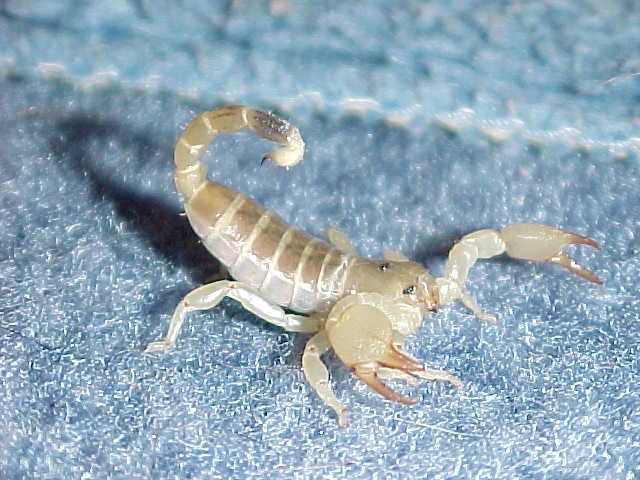Scorpio maurus |
||
|
||
Common names:
This was the first scorpion species scientific described
(by Linnaeus himself), and the name Scorpio means
scorpion. The specific name, maurus means dark or
obscure. The species is sometimes known a the Largeclawed
Scorpion or Israeli Gold Scorpion.
Distribution:
Africa (Algeria, Egypt, Libya, Mauritania, Morocco,
Senegal, Tunisia), Asia (Iraq, Iran, Israel, Jordan,
Kuwait, Lebanon, Quatar, Saudi Arabia, Syria, Turkey,
Yemen).
Habitat:
This species is often found in desert habitats, but can
also be found in dry forrests. It is a burrowing species,
which inhabits different types of substrats (burrowing
must be possible). The burrows are often 20 - 70 cm deep
(the bottom of the borrow is usually enlarged). This
species lives in very warm habitats, but will experience
winter temperatures down to 10-15 C in some areas (the
scorpion will "hibernate" in the burrow during
winter).
Venom:
Mildly venomous, but a painful sting. Harmless
for healthy humans. This aggressive species will often
use claws for defense, and not use the stinger. LD50
values are reported to be 9.37 - inactive (mg/kg) and
141.6 - inactive (mg/kg).
Selected litterature:
M.R. Warburg and R. Elias (1999). Differences in the
female reproductive system of Scorpio maurus fuscus
H.& E. (Scorpionidae) between two populations
inhabiting different regions in northern Israel. Israel
Journal of Zoology, Vol. 45(2), pp. 225-229.
Rutin, J. (1996) The burrowing activity of scorpions (Scorpio
maurus palmatus) and their potential contribution to
the erosion of Hamra soils in Karkur, central Israel.
Geomorphology, 15(2), pp. 159-168.
M. R. Warburg & Rivka Elias (1998). The reproductive
potential and strategy of Scorpio maurus fuscus
(Scorpiones: Scorpionidae): anatomical clues in the
ovariuterus. Journal of Zoology, vol. 246(1), pp. 29-37.
M. Shachak & S. Brand (1983). The relationship
between sit and wait foraging strategy and dispersal in
the desert scorpion, Scorpio maurus palmatus.
Oecologia, vol. 60, pp. 371-377.
On the Internet:
Scott
Stockwells Scorpion de Jour.
Jon
Fouskaris on Scorpion maurus
Picture
on the internet
Picture
on the internet
General:
This species is 6-8 cm long, and the different subspecies
(19 subspecies are described in Fet et al., 2000) are
varying in colors. Most have a yellow to redbrown color
(the tip of the claws are usually dark redbrown), but
some subspecies (like S. maurus fuscus) are dark
brown/blackish in color. The different subspecies can be
seperated by the color variations, but not always. It is
possible that some of the subspecies represent true
species, but a thorough revision of the genus is
necessary before any conclusion can be drawn.
This species is often found in colonies, but each scorpion has it's own burrow..
This species is kept in captivity. Breeding seems diffcult.
Scorpio maurus photo by Jeff Dawson (C)
